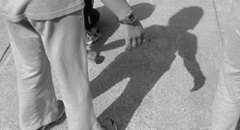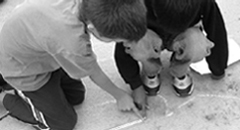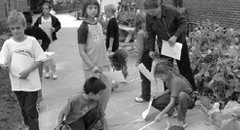
|

|

|
Making Learning Visible 2004: A Map of Our Work
THE INTENTIONALITY OF THE GROUP
How do learning groups form? How can we involve students in the process of forming groups? (Kerri-Lee, 6th grade)
What is the nature of tasks that seem especially effective in catalyzing a bunch of individuals into a learning group?? (Steve, PZ researcher)
THE DEVELOPMENT OF GROUP LEARNERS AND LEARNING GROUPS
What are the essential elements of a powerful learning group?* (Deb, 5th grade)
What are the cultural challenges that can limit our ability to consider new possibilities and opportunities for individual and group learning? Which aspects of culture support individual and group learning?* (Joan, h.s. professional development coach)
CULTURE, VALUES, AND DEMOCRACY
How and why does the culture of our educational system feel OK about the current design of measuring learning success? I am looking for the definition of what we are considering as important learning. (Betsy, kindergarten)
How can I use documentation to create a more equitable learning environment and demonstrate the value of equity in our learning together? (Jennifer, 9th grade)
How do I establish a culture of change? (Clancie, teacher educator)
THE RELATIONSHIP BETWEEN INDIVIDUAL AND GROUP
How do we balance the group's interests and learning experiences with a teacher's accountability to required goals and objectives or interests? (Joanne, kindergarten)
Which tasks are best suited for individual learning and which for group? How can I get kids to listen such that they value others' ideas, and their ideas are modified, developed, and advanced by the group?* (Heather, 9th grade)
How can we use meta-cognition and reflection to help change the group or individual identity especially if it is negative? What group tasks help students learn the benefits of listening to and trusting one another?* (Lindy, 9th grade)
INDICATORS OF UNDERSTANDING
How can I make ideas and thinking visible so that more participants are connected as a learning group? (Rachel, 7th and 8th grade)
What do children with special needs bring to the construction of knowledge in learning groups? (Karen, speech therapist)
How will information acquired from documentation be used to develop curriculum that will accelerate the learning processes and levels of students? (Adeleine, K-1st grade)
Without a learning group agreeing on principles of self-observation, how can they analyze their individual and group learning and deepen their level of learning in future discussions? (Chris L., 4th grade)
What are my theories about adult learning and how can I both document them and use them to further adult group learning?* (Phyllis, h.s. coach)
How do you help children and adults see themselves as learners in a group and why is this important?* (Stephanie, teacher educator)
How can we, as teacher educators and as student teachers, develop our knowledge and skills in order to understand and support children that lead to deeper and more productive play?* (Bobbi, teacher educator)
HOW LEARNING GROUPS FUNCTION
How can we better understand, document, and support children's learning in their dramatic play? (Ben, kindergarten)
What are the social and emotional components of group learning for adolescents, especially those with special needs? (Todd, special needs)
How do we get children to think of themselves as learners in a group and reflect on what is going on in their group? What is the value of that experience for them? (Marina, preschool)
Reggio educators suggest the bringing together of "children with complementary communicative strategies and ways of working." How do I maximize the potential of a group when my group's learning styles are less diverse than other groups? (Danikka, special needs)
How can children learn to support each other without the help of the facilitator? (Yvonne, toddlers)
MAKING LEARNING VISIBLE
How can we establish a culture of ethnography in our classrooms in which teachers and students document together in order to better understand our learning? (Maggie and Cheryl, 1st and 4th grades)
© 2004 Making Learning Visible Project at the Harvard Graduate School of Education
[Home] [Site Map]